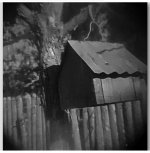Ambro51
Collector/Photographer
Ohhhh Yes. “Comic Book” Cameras...the Toy Cameras in the vending machine.....There are close to 500 variations of the basic cheap tin and plastic HIT camera. These toys are all very cheaply made copies of a group of quite capable miniature cameras originated in the late 1930’s in wartime Japan. Invented by Jilo Nakamura, the Midget used a format also designed by Nakamura, 17.5 mm roll film. Made by slitting unperforated 35 mm Cine stock to 200mm lengths, wrapped onto tiny spools with paper backing, frame numbers 1 to 10. The cameras are quite complicated, with f 4.5 Anastigmat three and four element lenses. Aperature settings are 4.5 to 11, with shutter speeds B 25, 50 and 100. Most are fixed focus, with the Tone camera alone having adjustable range settings of 2, 10 feet and infinity. Most have curved film planes, the Tone has a flatfocal plane. The shutter design is very similar on all, deriving from the Midget. Viewfinders are simple windows, not very accurately portraying the field. Weights range from about 80 grams to 140 ( Jilona midget). •••••••••. Are they “Real Cameras”? Oh YES! They all are very real and very useable today. With the cost of film now, consider properly slit, a roll of 120 film gives you Nine rolls of 17.5, That’s 90 exposures! Do the math, that’s Cheap film shooting. Small format, well, 110 is 13x17, these negatives are 14x14. So, if you can enjoy 110, here’s its Father.••••••• SPOOLS are the issue. An eBay seller had NOS rolls cheap, I bought three dozen. The film inside is removed, and in the dark bag a fresh cut strip of film is inserted, refilled and taped at the head. Ready to Shoot! The neat thing is you have unlimited film choices, currently I’m enjoying 1988 expired Verichrome, in 17.5 and getting Great results! Images are fully detailed and crisp, the lenses are really very good and you’d be surprised the degree of enlargement possible. The key is small aperature and a solidly braced camera, sun at your back. The Red film number windows are troublesome, I’ve closed mine and rely on “turns”. ~~~~~~~. So think about these high quality HIT type cameras, try and ignore all the cheap toy copies. They are FUN!


